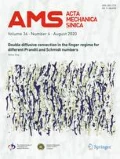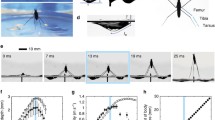Abstract
Mosquitoes possess the striking ability to walk on water because each of their legs has a huge water supporting force (WSF) that is 23 times their body weight. Aiming at a full understanding of the origins of this extremely large force, in this study, we concentrate on two aspects of it: the intrinsic properties of the leg surface and the active control of the initial stepping angle of the whole leg. Using a measurement system that we developed ourselves, the WSFs for the original leg samples are compared with those whose surface wax and microstructures have been removed and with those of a different stiffness. The results show that leg flexibility plays a dominant role over surface wax and microstructures on the leg surface in creating the supporting force. Moreover, we discuss the dependence relationship between the maximum WSF and the initial stepping angle, which indicates that the mosquito can regulate this angle to increase or decrease the WSF during landing or takeoff. These findings are helpful for uncovering the locomotion mechanism of aquatic insects and for providing inspiration for the design of microfluids, miniature boats, biomimetic robots, and microsensors.
Graphical abstract
The deformation and typical force curve of the mosquito leg when it is pressed onto a water surface.








Similar content being viewed by others
References
Wilcox, R.S.: Sex discrimination in Gerris remiqis: role of a surface wave signal. Science 206, 1325–1327 (1979)
Suter, R.B., Wildman, H.: Locomotion on the water surface: hydrodynamic constraints on rowing velocity require a gait change. J. Exp. Biol. 202, 2771–2785 (1999)
Hu, D.L., Bush, J.W.M.: The hydrodynamics of water-walking arthropods. J. Fluid Mech. 644, 5–33 (2010)
Gao, X.F., Jiang, L.: Water-repellent legs of water striders. Nature 432, 36 (2004)
Hu, D.L., Chan, B., Bush, J.W.M.: The hydrodynamics of water strider locomotion. Nature 424, 663–666 (2003)
Keller, J.B.: Surface tension force on a partly submerged body. Phys. Fluids 10, 3009–3010 (1998)
Feng, X.Q., Gao, X.F., Wu, Z.N., et al.: Superior water repellence ability of water strider’s legs with hierarchical structures: experiments and analysis. Langmuir 23, 4892–4896 (2007)
Vella, D., Lee, D.G., Kim, H.Y.: Sinking of a horizontal cylinder. Langmuir 22, 5979–5981 (2006)
Liu, J.L., Feng, X.Q., Wang, G.F.: Buoyant force and sinking conditions of a hydrophobic thin rod floating on water. Phys. Rev. E 76, 066103 (2007)
Zheng, Q.S., Yu, Y., Feng, X.Q.: The role of adaptive-deformation of water strider leg in its walking on water. J. Adhes. Sci. Technol. 23, 493–501 (2009)
Ji, X.Y., Wang, J.W., Feng, X.Q.: Role of flexibility in the water repellency of water strider legs: theory and experiment. Phys. Rev. E 85, 021607 (2012)
Burton, L.J., Bush, J.W.M.: Can flexibility help you float? Phys. Fluids 24, 101701 (2012)
Vella, D.: Floating objects with finite resistance to bending. Langmuir 24, 8701–8706 (2008)
Park, K.J., Kim, H.Y.: Bending of floating flexible legs. J. Fluid Mech. 610, 381–390 (2008)
Wu, C.W., Kong, X.Q., Wu, D.: Micronanostructures of the scales on a mosquito’s legs and their role in weight support. Phys. Rev. E 76, 017301 (2007)
Quere, D.: Rough ideas on wetting. Phys. A 313, 32–46 (2002)
Otten, A., Herminghaus, S.: How plants keep dry: a physicist’s point of view. Langmuir 20, 2405–2408 (2004)
Patankar, N.A.: On the modeling of hydrophobic contact angles on rough surfaces. Langmuir 19, 1249–1253 (2003)
Caponigro, M.A., Erilsen, C.H.: Surface film locomotion by the water strider. Gerris remigis say. Am. Midland Nat. 95, 268–278 (1976)
Peng, Y., Zhou, M.X.: Study on the structure and hydrophobicity of water strider’s tarsus. Biol. Teach. 3, 66–68 (2012)
Kong, X.Q., Wu, C.W.: Superior water repellency of mosquito legs with hierarchical micro-nanostructures. Chin. Sci. Bull. 16, 1589–1594 (2010)
Cassie, A.B.D., Baxter, S.: Wettability of porous surfaces. Tran. Faraday Soc. 40, 546–551 (1944)
Su, Y.W., Ji, B.H., Huang, Y.G., et al.: Nature’s design of hierarchical superhydrophobic surfaces of a water strider for low adhesion and low-energy dissipation. Langmuir 26, 18926–18937 (2010)
Liu, J.L., Sun, J., Mei, Y.: Biomimetic mechanics behaviors of the strider leg vertically pressing water. Appl. Phys. Lett. 104, 231607 (2014)
Kong, X.Q., Liu, J.L., Zhang, W.J., et al.: Load-bearing ability of the mosquito tarsus on water surfaces arising from its flexibility. AIP Adv. 5, 037101 (2015)
Acknowledgments
This work was supported by the National Natural Science Foundation of China (Grants 11302093, 11302094 and 11272357) and the Natural Science Fund for Distinguished Young Scholars of Shandong Province (JQ201302).
Author information
Authors and Affiliations
Corresponding author
Rights and permissions
About this article
Cite this article
Kong, XQ., Liu, JL. & Wu, CW. Why a mosquito leg possesses superior load-bearing capacity on water: Experimentals. Acta Mech. Sin. 32, 335–341 (2016). https://doi.org/10.1007/s10409-015-0458-x
Received:
Revised:
Accepted:
Published:
Issue Date:
DOI: https://doi.org/10.1007/s10409-015-0458-x




